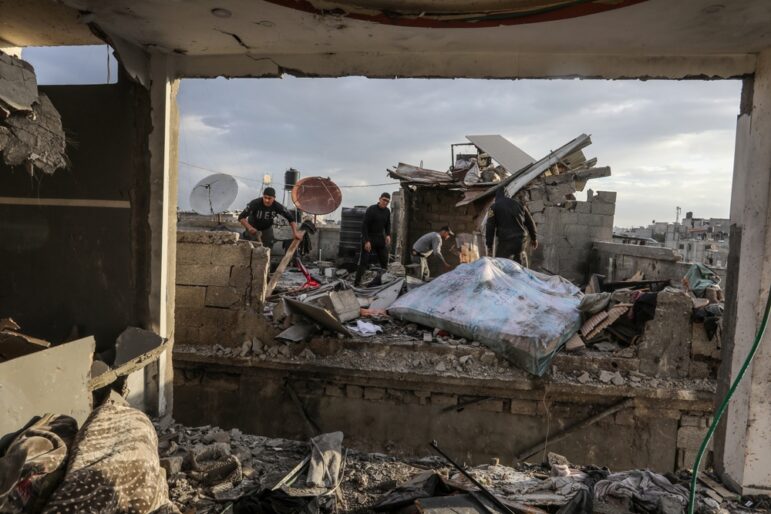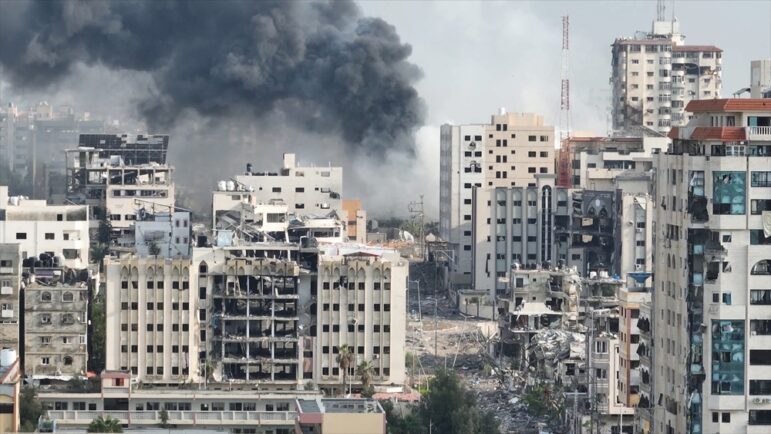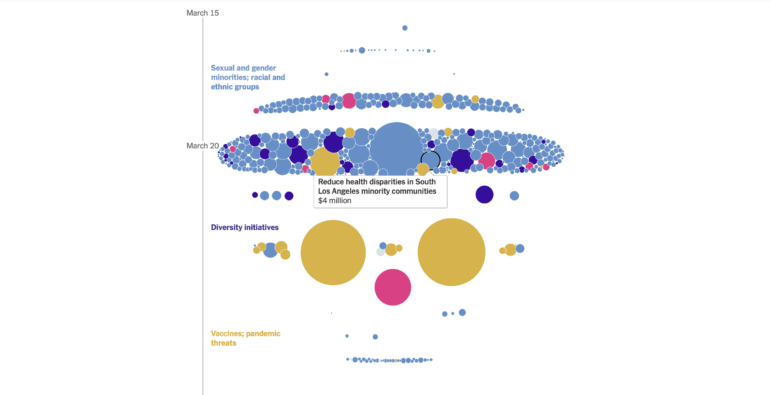

New York Times reporter Azmat Khan, speaking at a panel event in New York City. Image: Clarissa Villondo, Karlin Villondo Photography, republished under a CC license
This Reporter Exposed the Civilian Toll of US Airstrikes. Her Warning: Be Ready for a More Hostile World
Read this article in
Azmat Khan is a Pulitzer Prize-winning investigative journalist and a professor at the Columbia University Graduate School of Journalism. She works as an investigative reporter for The New York Times and The New York Times Magazine.
Known for her rigorous reporting on war, accountability, and government transparency, Khan has uncovered critical truths about civilian casualties from US military operations, challenging official narratives with open source intelligence (OSINT) investigations and reporting on the ground.
She won the 2022 Pulitzer Prize in International Reporting for her New York Times series The Civilian Casualty Files, a project which was the result of more than five years of extensive reporting, including on-the-ground investigations at over 100 civilian casualty sites across Iraq, Syria, and Afghanistan. The series was published after a legal battle that uncovered more than 1,300 military records which were previously classified.
Her 2017 investigation, The Uncounted, revealed that US airstrikes in Iraq killed civilians at a rate 31 times higher than the military admitted. During her time at BuzzFeed News, one of her investigations, Ghost Schools, exposed deep corruption in the US-funded education programs in Afghanistan.
Khan’s work has not only exposed systemic failures in military and government accountability but has also set new standards for investigative journalism. I spoke to her recently at her office in New York. She discussed her investigative methods, the ethical complexities of war reporting, and the growing challenges facing journalists in an era of increasing surveillance and shrinking press freedoms.
Q: Your work has uncovered critical insights into civilian casualties from US drone strikes. What drew you into this area of investigative journalism?
Azmat Khan: Back in 2008 and 2009, there was an unprecedented surge of drone strikes in Pakistan. This brought up new questions about how wars are conducted and what the United States is doing globally. Over the next few years, we saw this kind of warfare expand to places like Yemen. Air strikes, not just drone strikes, increasingly became the US strategy to avoid deploying large numbers of ground troops.
What drew me to this topic was seeing how claims made by the US military often went unchallenged. There was one statistic in particular that became a turning point for me.
In April 2016, I read a front-page news article claiming the US had killed around 25,000 ISIS fighters in Iraq and Syria. At the same time, I had been tracking the US-led coalition’s own data, which assessed that only 24 civilians had been killed. These numbers, 25,000 fighters against 24 civilians, seemed completely at odds with what I knew to be a reality, but they were often being accepted as fact.
And I just thought to myself, can I verify these statistics? Can I visit a village or a town, investigate every airstrike site, and determine how many strikes actually resulted in civilian casualties? How precise are these claims?
Q: How did you start?
AK: I decided to start small. The first area I focused on was near Qayyarah, Iraq, halfway between Erbil and Mosul. I visited 10 strike sites, and half of them had resulted in civilian casualties. This was shocking, and I realized I needed to expand my sample. I kept returning to investigate further.
This work eventually led to the findings published in The Uncounted in 2017. Based on a sample of 103 airstrikes, my co-author and I discovered that one in five airstrikes resulted in civilian casualties, a rate 31 times higher than the US-led coalition’s claim of less than 1%. This became the foundation for my subsequent years of investigation into the true impact of US airstrikes.
Q: How did you approach investigating military claims?
AK: In a post-9/11 context, the military often makes claims about targets without being transparent about the underlying rationale or intelligence used to justify those actions. They frequently cite national security to obscure details, making it difficult for journalists to challenge their findings.
To address this lack of transparency, I employed several strategies. First, I recognized the importance of going on the ground to gather first-hand information, as the military often did not investigate incidents themselves. This allowed me to conduct my own intelligence gathering, which is essentially what journalism is, intelligence gathering for the public.
Second, I systematically analyzed military press releases, strike summaries, and casualty assessments, compiling them into a database to identify patterns or inconsistencies. I also interrogated their public claims to determine their accuracy.
Third, I pursued the military’s underlying rationale through various means, including interviews with coalition actors, embedding at a US air base in Qatar, and using the Freedom of Information Act (FOIA) to request records. This approach allowed me to challenge the military’s narrative and provide a more accurate account of events.
Q: Why was obtaining military assessments through FOIA requests so important?
AK: It was a game changer. In The Uncounted, I discovered that one in five airstrikes resulted in civilian casualties, with half linked to poor or outdated intelligence. By creatively arguing under FOIA, I secured a military assessment that revealed how intelligence had gone awry in a specific case, such as the airstrike involving Basim Razzo.
This success motivated me to pursue thousands of other assessments, leading to the Civilian Casualty Files project. After years of submitting FOIA requests and eventually suing the Pentagon, I obtained over 1,300 records. These documents allowed me to interrogate the military’s claims, examine their underlying intelligence, and fill the information gap often exploited by governments.
Q: What was the impact on your work?
AZ: The impact was profound. By combining these records with on-the-ground investigations, I was able to provide a comprehensive account of civilian casualties, holding the military accountable, and shedding light on their decision-making processes.
Q: How do you approach interviewing survivors and families affected by war?
AK: This is such a good question. One thing I recommend is time. Giving people space to tell their stories and really listening to them, not just asking the questions you’re interested in. This helps build trust and allows them to open up. Many survivors have never spoken to a journalist before or don’t know the rules.
In some cultures, there’s a deep respect for guests, so they may feel obligated to answer questions even if they’re uncomfortable. I always inform them upfront: You don’t have to answer any of my questions. If I ask something hurtful or harmful, you don’t have to respond. I’m also mindful of children’s presence and adjust accordingly.
After asking about traumatic experiences, it’s my responsibility to bring them to a lighter space. I often transition to questions about their hopes, faith, or passions.
I also recommend resources like the Dart Center at Columbia, which offers practical tips for interviewing trauma survivors. They highlight things like “hot moments,” where physical signs show someone is re-experiencing trauma, helping you adjust your approach. I have learned to adapt my methods based on context. What works in Afghanistan might not work in Iraq or Syria. It’s about balancing sensitivity with gathering meaningful stories.
Q: How do you approach interviewing survivors of trauma, especially when revisiting deeply painful experiences?
AK: I was often surprised by how much survivors wanted to share, even when I offered to stop. Many found it therapeutic or appreciated having someone listen. Sometimes, interviews would end, but the person didn’t want to stop, and I’d spend hours listening.
For example, I went with Basim to the house where he survived an airstrike but lost his wife, daughter, brother, and nephew. I knew that would be traumatic, but he told me he wanted to go. He said, ‘I’m numb,’ but at one point he did break down. He started crying when he went to the laundry room, and it was because he saw his daughter’s heel in the rubble. That moment became a core part of the story, and he was comfortable with how we told it.
Watching him break down, I felt sad and guilty, but also honored to witness his journey. If I could accurately convey his story, and he wanted it shared, it was worth it.
It is also important to get meaningful consent. My colleague Jina Moore wrote about this, emphasizing that it’s not enough to just ask for an interview. You must explain who you are, where the story will appear, and the potential risks. Survivors need to understand the impact their story could have.
Q: How did you start using OSINT, and what tools or methods have you found most effective?
AK: For every investigation I’ve done in the last decade, OSINT tools have been essential for data gathering and analysis. For example, in my BuzzFeed News Ghost Schools investigation in Afghanistan, I used the Wayback Machine, Internet Archive, and satellite imagery to track government claims and verify the schools on the ground.
Over time, I’ve improved my use of these tools. For The Uncounted, I used Google Earth, Planet Labs, and Sentinel Hub to cross-check strike sites and dates reported by witnesses. These tools helped me see before-and-after changes and verify events.
Crowdsourced maps like Wikimapia were also useful in Iraq, where locals labeled locations, enabling deeper searches. I also used time-bound searches on TweetDeck and deep web searches to find and archive videos, especially those deleted by groups like ISIS.
Q: Did you use archiving and monitoring tools?
AK: Those were critical. I often saved videos I knew would be taken down, systematically saving and analyzing them. For example, I compiled videos uploaded by the US-led coalition to YouTube and dvidshub.net (Defence Visual Information Distribution Service), building databases to study them.
This was crucial for accountability. When the coalition denied conducting a strike in a specific area, I used archived videos to prove they had. This revealed inaccuracies in their strike logs and highlighted flaws in their reporting systems.
There are countless tools available, but one I find particularly useful is Visualping. It tracks changes on websites and alerts you based on your preferences, whether daily emails or checks every five minutes.
This tool helped me discover that the coalition had removed strike videos from YouTube, coinciding with my inquiries about those videos. Monitoring changes like this is crucial for accountability and adds significant value to reporting.
Tools like reverse image search also allowed me to check when and where content first appeared, whether it matched the date in question, and if it had been altered over time. This was crucial for verification and fact-checking.
I recommend practicing with these tools regularly. Many platforms, like Planet Labs, offer free or discounted access to journalists. Combining on-the-ground reporting with OSINT tools has been key to challenging official narratives and uncovering the truth.
Q: And yet OSINT techniques have some limitations. How have you navigated them?
AK: OSINT tools can seem like a magic wand in journalism, but they have limitations. Relying exclusively on OSINT risks flattening people’s stories. If you only use satellite imagery or online reports without speaking to people, you miss the complexity and humanity of their lives.
Sometimes, stories relying solely on OSINT can feel technical and void of human emotion. Speaking to people, understanding their complex lives, and rendering their lives meaningful – that’s essential to journalism. Whether you reach them on the ground, remotely, or through their online presence, elevating their voices is crucial.
Q: What strategies have worked for you for FOIA requests?
AK: The key to FOIA success is doing your research. Understand the agency, what the records are called, and where they are kept so you can submit a precise request. It also helps to look into the agency’s track record, how responsive they are, how long they usually take, and their policies on expedited processing.
A great resource in the US is the FOIA Wiki by the Reporters Committee for Freedom of the Press. It helps you navigate the process and understand how different agencies handle requests. If an agency is slow, you may want to request expedited processing. Journalists often cite public interest, but some agencies offer other grounds. When I was investigating a case where a civilian’s life was at risk because of a military error, I argued that disclosure could prevent harm, and that helped me get the records.
Q: Can you share an example?
AK: Basim Razzo feared for his life after a coalition video labeled his and his brother’s home a “car bombing factory.” I knew military records showed this was a mistake, but the video remained online, seen by thousands.
I argued under FOIA that releasing these records was crucial for public accountability and to protect Basim’s safety. This helped me obtain the records, and I used the same rationale in subsequent requests.
Persistence is key. If an agency delays or denies your request, you might need legal action. I had to sue, and the Reporters Committee represented me. They offer legal support and have a hotline for journalists.
The last thing I’d say is to stay organized. Keep track of your FOIA requests, responses, and follow-ups. It strengthens your case if you need legal help and shows the public interest in your work.
Q: What mistakes do journalists make when submitting FOIA requests?
AK: I often feel guilty talking about America and freedom of information when speaking to journalists from other countries. While many nations have these laws on the books, they often don’t work in practice. Take the UK, for example. NGOs tracking civilian casualties have been fighting for years to get just one military assessment released, with no success. Meanwhile, I’ve obtained more than 2,000 such assessments through the US system.
That said, even in countries where FOIA systems do function, I’ve seen journalists make some common mistakes that can derail their efforts. One major pitfall is being too broad. If you ask for ‘all records related to X,’ you are likely to get stuck in bureaucratic limbo. The key is being specific. You need to demonstrate that the exact records you are seeking exist, and request them precisely.
Another critical point is understanding what FOIA can and can’t do. Government agencies won’t create new documents or do analysis for you. You can only request existing records in their current form. This trips up a lot of people who expect agencies to compile information on their behalf.
You need to track all correspondence, follow up when deadlines pass, and understand the appeals process before considering litigation. In the US, for example, you have to exhaust all administrative remedies before you can file a lawsuit — miss that step and your case is dead in the water.
It’s also important not to put all your eggs in the FOIA basket. Sometimes the documents you need are already publicly available, just buried in obscure corners of government websites. Learning advanced search techniques — like searching for specific file types — can uncover gems. And of course, cultivating sources remains as important as ever.
Q: How do you see the current political climate affecting investigative journalism?
AK: We are going to see more surveillance of journalists. The digital surveillance of reporters has intensified dramatically, with governments and other actors deploying increasingly sophisticated tools to monitor journalists online.
We are going to see less access for journalists. We are already seeing that. Foreign journalists are not allowed into Gaza, with both Israel and Egypt refusing them entry. What’s most disturbing isn’t just the blockade itself, but the muted international response. Aside from a handful of US senators, there’s been no meaningful pushback from world powers.
We’ve crossed a red line where governments now feel emboldened to openly admit they are targeting journalists without facing consequences. When powerful nations fail to challenge these actions, it sends a green light to authoritarian regimes everywhere. The message is clear: you can eliminate unwanted reporting and face no repercussions.
At its core, this crackdown reveals how threatened power structures feel by investigative journalism. Real accountability reporting remains one of the last effective checks on authority, which is exactly why we’re seeing such coordinated efforts to undermine it.
The tactics being pioneered in Gaza – complete information blackouts, attacks on journalists with impunity – risk becoming the new normal unless the international community wakes up to what’s at stake. These aren’t abstract concerns anymore. We are watching the playbook for silencing investigative journalism being written in real time.
This is an extract from an article originally published by the Reuters Institute and is republished here with permission.
Maurice Oniang’o is an award-winning freelance multimedia journalist and documentary filmmaker based in Nairobi, Kenya. He has written for National Geographic, 100 Reporters, Africa.com, and Transparency International, among others. A National Geographic Explorer recipient, he has also produced documentaries for National Geographic’s Ultimate Vipers, as well as Project Green, Africa Uncensored, NTV Wild, and Tazama.










